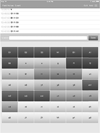An Ethogram to Quantify Operating Room Behavior
- PMID: 26813263
- PMCID: PMC5320891
- DOI: 10.1007/s12160-016-9773-0
An Ethogram to Quantify Operating Room Behavior
Abstract
Background: The operating room (OR) is a highly social and hierarchical setting where interprofessional team members must work interdependently under pressure. Due primarily to methodological challenges, the social and behavioral sciences have had trouble offering insight into OR dynamics.
Purpose: We adopted a method from the field of ethology for observing and quantifying the interpersonal interactions of OR team members.
Methods: We created and refined an ethogram, a catalog of all our subjects' observable social behaviors. The ethogram was then assessed for its feasibility and interobserver reliability.
Results: It was feasible to use an ethogram to gather data in the OR. The high interobserver reliability (Cohen's Kappa coefficients of 81 % and higher) indicates its utility for yielding largely objective, descriptive, quantitative data on OR behavior.
Conclusions: The method we propose has potential for social research conducted in healthcare settings as complex as the OR.
Keywords: Health communication; Health services research; Worksite health.
Conflict of interest statement
Figures

References
-
- Rogers DA, Lingard L, Boehler ML, et al. Surgeons managing conflict in the operating room: Defining the educational need and identifying effective behaviors. Am J Surg. 2013;205(2):125–130. - PubMed
-
- Rogers DA, Lingard L. Surgeons managing conflict: A framework for understanding the challenge. J Am Chem Soc. 2006;203(4):568–574. - PubMed
-
- Rogers DA, Lingard L, Boehler ML, et al. Foundations for teaching surgeons to address the contributions of systems to operating room team conflict. Am J Surg. 2013;206(3):428–432. - PubMed
-
- King HB, Battles J, Baker DP. Advances in Patient Safety: New Directions and Alternative Approaches. Vol. 3. Rockville, MD: AHRQ; 2008. Teamstepps™: Team strategies and tools to enhance performance and patient safety. Retrieved from http://teamstepps.ahrq.gov. - PubMed
Publication types
MeSH terms
Grants and funding
LinkOut - more resources
Full Text Sources
Other Literature Sources
Medical

